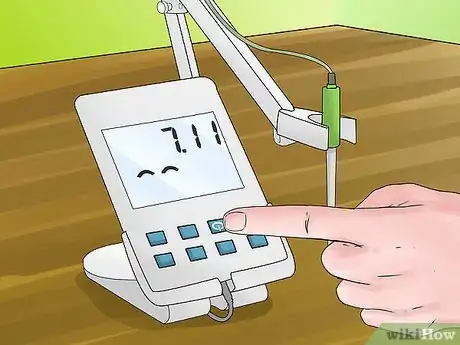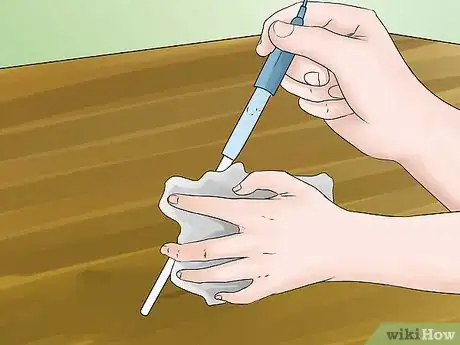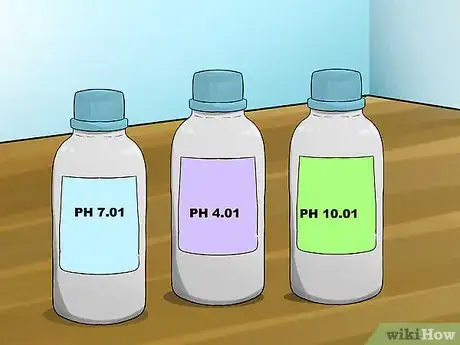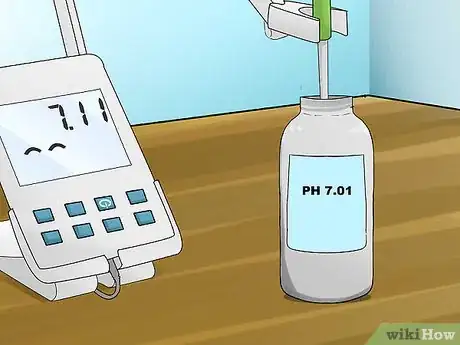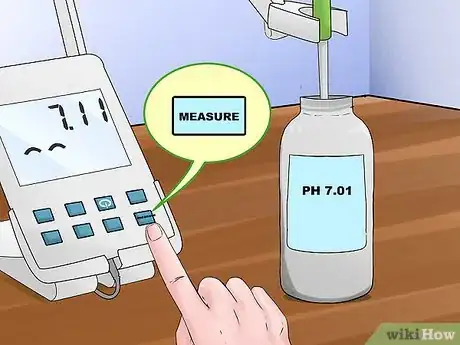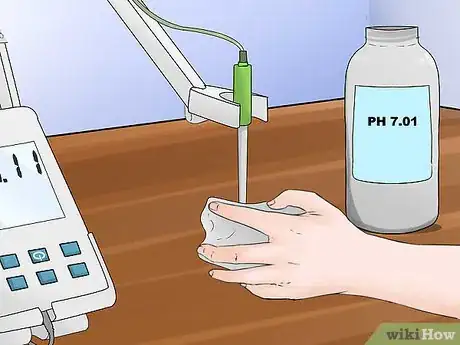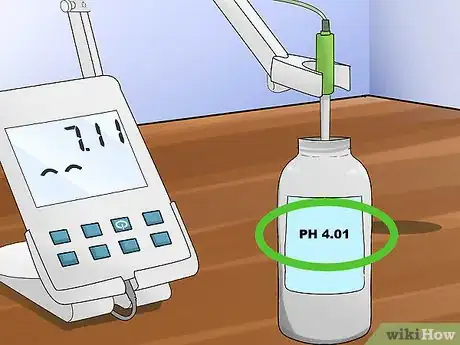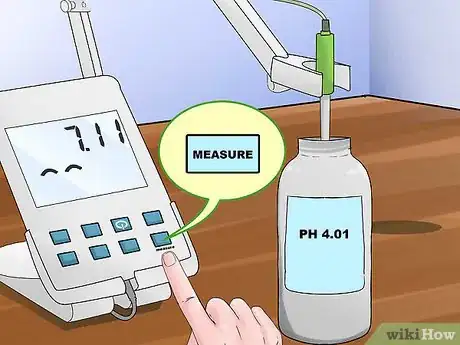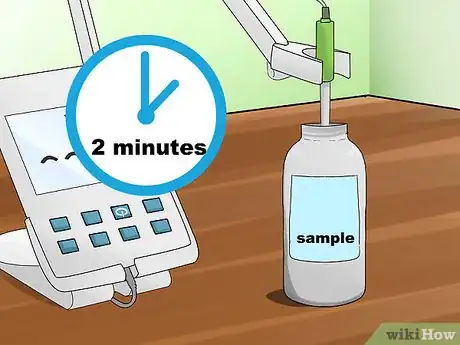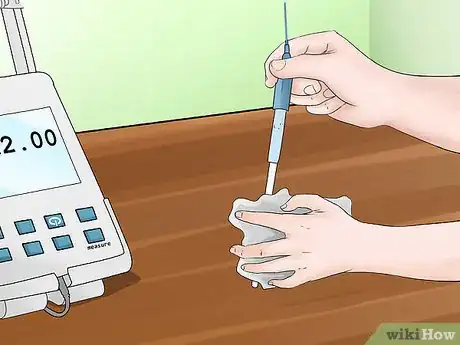This article was co-authored by Bess Ruff, MA. Bess Ruff is a Geography PhD student at Florida State University. She received her MA in Environmental Science and Management from the University of California, Santa Barbara in 2016. She has conducted survey work for marine spatial planning projects in the Caribbean and provided research support as a graduate fellow for the Sustainable Fisheries Group.
wikiHow marks an article as reader-approved once it receives enough positive feedback. In this case, 84% of readers who voted found the article helpful, earning it our reader-approved status.
This article has been viewed 660,458 times.
Chemists, biologists, environmentalists, and lab technicians alike all use pH to measure the acidic and basic potentials of a solution. A pH meter is very useful and the most accurate tool available to test pH levels. There are many simple steps, from preparing your materials to methodically calibrating and testing, to ensure you have the most accurate reading of pH levels possible.
Steps
Preparing for Calibration
-
1Turn on your pH meter. Before you begin to calibrate and use your pH meter you will first need to turn it on and allow adequate time for the meter to warm up. This should generally take around 30 minutes, but check your pH meter's operating manual for exact times.
-
2Clean your electrode. Take the electrode out of its storage solution and rinse it with distilled water under an empty waste beaker. Once rinsed, blot dry with Kimwipes or Shurwipes, which are available at most office supply stores.[1]
- Be sure to rinse your electrode in a waste beaker that is different from the beaker you will be calibrating in.[2]
- Avoid rubbing the electrode as it has a sensitive membrane around it.
- If you find the electrode to be particularly dirty consult your operating manual for recommended cleaning solutions.
Advertisement -
3Prepare your buffers. You will generally need more than one buffer for calibrating a pH meter. The first will be a “neutral” buffer with a pH of 7, and the second should be near the expected sample pH, either a pH of 4 or 9.21. Buffers with a higher pH (9.21) are best for measuring bases, whereas buffers with a low pH (4) are best for measuring acidic samples. Once you have chosen your buffers allow them to reach the same temperature as the pH meter because pH readings are temperature dependent. Pour your buffers into individual beakers for calibration.[3]
- Check with your pH meter manufacturer, or current educational or professional institution, about acquiring pH buffer solutions.
- Buffers should be kept in a beaker for no longer than two hours.
- Discard the buffer when you are finished. Do not return it to its original container.
Calibrating Your pH Meter
-
1Place your electrode in the buffer with a pH value of 7 and begin reading. Press the “measure” or calibrate button to begin reading the pH once your electrode is placed in the buffer.
- Allow the pH reading to stabilize before letting it sit for approximately 1-2 minutes.
-
2Set the pH. Once you have a stable reading, set the pH meter to the value of the buffer's pH by pressing the measure button a second time. Setting the pH meter once the reading has stabilized will allow for more accurate and tuned readings.[4]
- Although not necessary, if you stir your buffer before measuring be sure to stir all other buffers and samples in the same way.
-
3Rinse your electrode with distilled water. Rinse and pat dry with a lint-free tissue, like Kimwipes or Shurwipes, in between buffers.[5]
-
4Place your electrode in the appropriate buffer for your sample and begin reading. Press the measure button to begin reading the pH once your electrode is placed in the buffer.[6]
-
5Set the pH a second time. Once your reading has stabilized, set the pH meter to the value of the buffer's pH by pressing the measure button.[7]
-
6Rinse your electrode. You can use distilled water to rinse. Use a lint-free tissue, like Kimwipes or Shurwipes, in between buffers to dry the electrode.
Using Your pH Meter
-
1Place your electrode in your sample and begin reading. Once your electrode is placed in your sample, press the measure button and leave the electrode in your sample for approximately 1-2 minutes.[8]
-
2Set your pH level. Once the reading has stabilized, press the measure button. This is the pH level of your sample.[9]
-
3Clean your electrode after use. Rinse your electrode with distilled water and blot or dab dry with a lint-free tissue. You may store your pH meter once clean and dry.
- Consult your operation manual for optimal storage practices for your specific pH meter.
Expert Q&A
-
QuestionHow do I discuss the pH meter calibration report when writing a standard operation procedure?
 Bess Ruff, MABess Ruff is a Geography PhD student at Florida State University. She received her MA in Environmental Science and Management from the University of California, Santa Barbara in 2016. She has conducted survey work for marine spatial planning projects in the Caribbean and provided research support as a graduate fellow for the Sustainable Fisheries Group.
Bess Ruff, MABess Ruff is a Geography PhD student at Florida State University. She received her MA in Environmental Science and Management from the University of California, Santa Barbara in 2016. She has conducted survey work for marine spatial planning projects in the Caribbean and provided research support as a graduate fellow for the Sustainable Fisheries Group.
Environmental Scientist This article provides a solid outline for how you should write up the calibration steps in any formal lab report. You'll want to be sure to mention which buffer you used and why as well as the temperature of all components involved.
This article provides a solid outline for how you should write up the calibration steps in any formal lab report. You'll want to be sure to mention which buffer you used and why as well as the temperature of all components involved. -
QuestionIs it always necessary to calibrate the pH meter before using?
 Community AnswerUsually daily calibration is necessary.
Community AnswerUsually daily calibration is necessary. -
QuestionMy Jellas pH meter recommends calibrating with deionized water. Is deionized water necessary, or can distilled water be used?
 Michael LiCommunity AnswerDeionized water basically means water without any ionic charges. It requires ion exchangers to perform the process. However, distilled water will work fine.
Michael LiCommunity AnswerDeionized water basically means water without any ionic charges. It requires ion exchangers to perform the process. However, distilled water will work fine.
Warnings
- Follow all other set safety regulations when working with hazardous samples.⧼thumbs_response⧽
Things You'll Need
- pH meter
- Distilled water
- Kimwipe or Shurwipe, a special thin tissue specifically for laboratory use
- pH 9.21 buffer, a solution whose pH is constantly 9.21
- pH 7 buffer, a solution whose pH is constantly 7
- pH 4 buffer, a solution whose pH is constantly 4
References
- ↑ https://sciencing.com/clean-ph-meter-4812473.html
- ↑ http://tools.thermofisher.com/content/sfs/brochures/TN-ph-calibration-procedure-for-optimal-measurement-precision-T-PHCAL-EN.pdf
- ↑ http://tools.thermofisher.com/content/sfs/brochures/TN-ph-calibration-procedure-for-optimal-measurement-precision-T-PHCAL-EN.pdf
- ↑ http://tools.thermofisher.com/content/sfs/brochures/TN-ph-calibration-procedure-for-optimal-measurement-precision-T-PHCAL-EN.pdf
- ↑ https://sciencing.com/calibrate-ph-meter-4796148.html
- ↑ https://sciencing.com/calibrate-ph-meter-4796148.html
- ↑ http://tools.thermofisher.com/content/sfs/brochures/TN-ph-calibration-procedure-for-optimal-measurement-precision-T-PHCAL-EN.pdf
- ↑ https://bitesizebio.com/8750/how-to-care-for-your-ph-meter/
- ↑ http://tools.thermofisher.com/content/sfs/brochures/TN-ph-calibration-procedure-for-optimal-measurement-precision-T-PHCAL-EN.pdf
About This Article
To calibrate and use a pH meter, prepare a neutral buffer with a pH of 7 and a second buffer with a pH of 4 for acidic samples or 9.21 for base samples. Next, put a clean electrode in the neutral buffer and press the “Measure” or "Calibrate" button. Once you have a stable reading, set the pH meter to the buffer’s pH value by pressing "Measure" a second time. Don't forget to rinse your electrode with distilled water before moving on to the next buffer! For more tips on preparing buffer solutions, read on!
